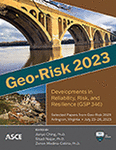Probability of Levee Instability following Rapid Drawdown
Publication: Geo-Risk 2023
ABSTRACT
Levees face the hazard of water side slope instability following water rise and subsequent rapid drawdown. Levee structures tend to be highly variable with sparse data to define soil properties. In addition, the hydraulic loading conditions for levees are largely controlled by natural processes, such as floods and storm surge, resulting in additional uncertainty. In this probabilistic parametric study, a hypothetical levee structure is examined using a variety of soil properties, including silty and clayey sands (SM and SC), silt (ML), and low and high plasticity clays (CL and CH). Typical properties (unit weight, coefficient of compressibility, and shear strength) will be assigned to each soil type along with high coefficients of variation, modeling highly variable levee materials. Four loading conditions were considered, combining long (three month) or short duration (two week) water rise with high (90% full) or moderate (50% full) water level. The start-of-drawdown seepage conditions and undrained shear strength properties for rapid drawdown analysis were modeled with simplified approaches appropriate to levees. Levees built from SM and SC soils were more sensitive to rapid drawdown due to greater progression of seepage and require careful characterization of undrained behavior. Levees built from clayey soils are unlikely to experience substantial seepage during flooding, making rapid drawdown much less important. Due to intermediate properties, the ML levee showed the most influence of the flood duration.
Get full access to this article
View all available purchase options and get full access to this chapter.
REFERENCES
Baecher, G. B., and Christian, J. T. (2005). Reliability and statistics in geotechnical engineering. John Wiley & Sons.
Ching, J., and Schweckendiek, T. (2021). State-of-the-art review of inherent variability and uncertainty in geotechnical properties and models, ISSMGE, 215 pp.
Desai, C. (1972). “Seepage analysis of earth banks under drawdown.” Journal of Soil Mechanics and Foundations Division, 98(SM11), 1143–1162.
Desai, C., and Sherman, W. C. (1971). “Unconfined transient seepage in sloping banks.” Journal of Soil Mechanics and Foundations Division, 97(SM2), 357–373.
Duncan, J. M. (2000). “Factors of safety and reliability in geotechnical engineering,” Journal of Geotechnical Engineering, 126(4), 307–316.
Duncan, J. M., Wright, S. G., and Wong, K. S. (1990). “Slope stability during rapid drawdown,” In Vol. 2 of Proc., H. Bolton Seed Memorial Symp. 253–72. Vancouver, BC: BiTech Publishers.
Poston, K. B. (2018). Parametric study of levee saturation for undrained rapid drawdown analysis. M.S. thesis. Tennessee Technological University.
Poston, K. B., Turkson, P., and VandenBerge, D. R. (2018). “Parametric study of levee saturation for undrained rapid drawdown analysis,” Proc. of USSD 2018, 15 pp.
Prakash, A., Hazra, B., and Sreedeep, S. (2019). “Probabilistic analysis of unsaturated fly ash slope,” Journal of Hazardous, Toxic, and Radioactive Waste, 23(1), 06018002. https://doi.org/10.1061/(asce)hz.2153-5515.0000428.
Rios, A. C., Porfírio, M., and Assis, A. (2017). “A probabilistic approach to the stability of a dam under rapid drawdown conditions,” PanAm Unsaturated Soils 2017. https://doi.org/10.1061/9780784481691.012.
Rocscience. (2022). “2D Slope Stability Software,” https://www.rocscience.com/software/slide2.
Shahin, M., and Cheung, E. M. (2011). “Probabilistic analysis of bearing capacity of strip footings,” Geotechnical Safety and Risk. ISGSR 2011, 225–230.
Spencer, E. (1967). “A method of analysis of the stability of embankments assuming parallel inter-slice forces,” Geotechnique, 17(1), 11–26.
Tao, B., and Zhang, D. (2016). “Probabilistic stability analysis of unsaturated soil slopes under rainfall,” Geo-China 2016. https://doi.org/10.1061/9780784480007.013.
Turkson, P. (2018). Effect of initial suction and levee foundation conditions on the saturated zone during flooding for rapid drawdown analysis, M.S. thesis, Tennessee Technological University.
Turkson, P., VandenBerge, D. R., and Boeglin, E. R. (2020). “Unsaturated soil model effects on the propagation of the saturated zone in levees during flooding,” In Proc. Dam Safety 2020, 1083. Lexington, KY: Association of State Dam Safety Officials.
Turkson, P. (2021). Total and effective stress rapid drawdown analysis of levees. Ph.D. dissertation, Tennessee Tech.
Vahedifard, F., Azhar, M., and Aghakouchak, A. (2022). “Adaption strategies for levees under a changing climate,” GeoStrata, June/July, Geo-Institute, ASCE.
VandenBerge, D. R. (2014). Total stress rapid drawdown analysis using the finite element method. Ph.D. dissertation, Virginia Tech.
VandenBerge, D. R., and McGuire, M. (2017). “Response surfaces for probabilistic analyses of slope stability,” Proc. of 19th Intl. Conf. Soil Mech. and Geotech. Eng., Seoul, 4 pp.
Wolff, T. F., Hassan, A., Khan, R., Ur-Rasul, I., and Miller, M. (2004). Geotechnical Reliability of Dam and Levee Embankments., USACE, Washington, D.C.
Information & Authors
Information
Published In
History
Published online: Jul 20, 2023
ASCE Technical Topics:
- Clays
- Drawdown (hydrology)
- Floods
- Geomechanics
- Geotechnical engineering
- Groundwater
- Hydraulic engineering
- Hydraulic structures
- Levees and dikes
- Material mechanics
- Material properties
- Materials engineering
- Seepage
- Shear strength
- Soil mechanics
- Soil properties
- Soils (by type)
- Strength of materials
- Water (by type)
- Water and water resources
- Water management
- Wells (water)
Authors
Metrics & Citations
Metrics
Citations
Download citation
If you have the appropriate software installed, you can download article citation data to the citation manager of your choice. Simply select your manager software from the list below and click Download.
